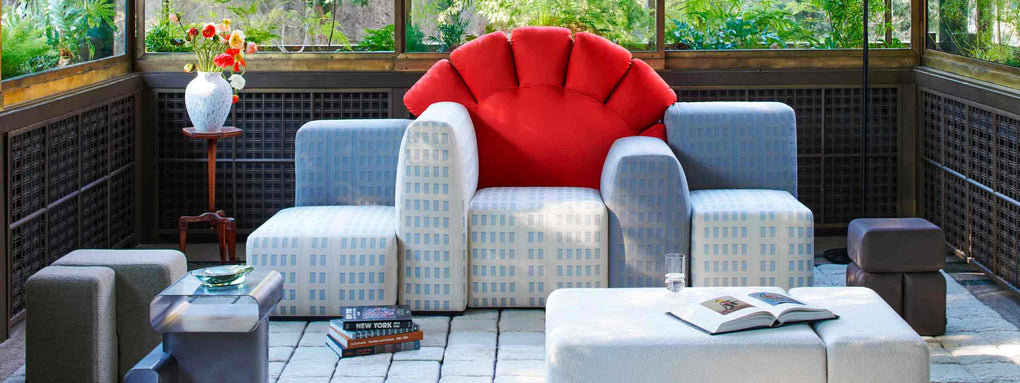DRIADE:
A VERY ITALIAN STORY
The List #21
By Antonella Dedini

The founders of Driade: Enrico Astori, Antonia Astori, and Adelaide Acerbi (Courtesy Elisa Astori)
Driade was founded in 1968 by Enrico Astori with his sister Antonia, an architect and designer, and his wife Adelaide Acerbi. In the landscape of Italian design, the company has always represented a symbol of innovation and creativity, leaving an indelible mark in the world of furniture and home accessories. From its beginnings, Driade has become a refined aesthetic laboratory constantly seeking beauty in living spaces. The highly flexible and compositionally rich furniture has consistently provided a precise response to the specific and intricate needs dictated by contemporary living.
Its legacy of creativity, research, and collaboration with the international design world is the foundation of its continuous success today. Building upon the legacy of this extensive collaboration and quality that shaped its DNA, Driade has managed to stay in tune with the times. It is, therefore, a distinctly Italian story born out of strong family synergy and collaboration—a narrative of commitment, passion, and dedication to the world of design from its inception to the quality of its production and product communication: an indelible DNA evident today.
Now, let's delve into the heart of this success story with the timeless projects and achievements that still define its path.
The Vision of Adelaide Acerbi

Portrait of Adelaide Acerbi (Courtesy Elisa Astori)
The Avant-Garde of Nanda Vigo

Nanda Vigo, Blocco pouf, 1970 (Courtesy Elisa Astori)
Blocco emerges with a focus on formal reduction and immediately becomes a symbol of a new concept of informal living. This predates art-design, the Campana brothers, and neo-baroque—a genius at work.
The Creativity of Antonia Astori
 Antonia Astori, Oikos System, 1973
Antonia Astori, Oikos System, 1973
The Style, Elegance, and Purity of Enzo Mari

Enzo Mari, Elisa Armchair, 1974


The Grand Collaboration with Alessandro Mendini and Achille Castiglioni

Alessandro Mendini, Sabrina Armchair, 1981, Photograph taken in Mendini's studio in Milan (Courtesy Elisa Astori)
It is the re-design of the classic bergère armchair with headrest ears, adding geometric structural elements and an unusual angular result softened by the use of intense red leather. The name itself, Sabrina, aimed to give a romantic yet decisive touch. Perhaps a nod to the famous film directed by Billy Wilder with Audrey Hepburn?
The Internationalization of Driade

Philippe Starck, Lou Read Armchair, 2011
The Art of Objects: The first collection of decorative objects complementing furniture + The Art of Table Setting

Borek Sipek, Les Folies Collection, 1988
Sipek is a Bohemian artist who develops an original neo-baroque language using blown glass, according to his tradition, silver, and precious woods, collaborating with Driade over the years.

Antonia Astori and Giuseppe Ragazzini, The White Snow Porcelain Plates - Bestiary of the Table
This plate collection stems from the artist Ragazzini's passion for pictorial metamorphosis and the possible combinations, pairings, and multiple interlocks originally inspired by his animated collages of imaginative animals.

Ron Arad, MT3 Armchair, Compasso d'Oro ADI, 2008
Rocking armchair-sculpture in a single block of polyethylene. "MT" is pronounced "empty," which in English means void, like the void formed in the center of its structure, a protagonist of its form and function. The first two-tone furniture element made with rotational molding.

Fabio Novembre, Nemo Armchair, 2010
For Fabio Novembre, design is narrated through stories that often take on the appearance of human figures, almost perfect and mythicized, as in ancient Greece. Nemo is a chair with a back that reproduces a head with a wonderful face. A mask that reveals and conceals its inhabitant.

Konstantin Grcic, Mingx Seating Family, 2016, Wallpaper Design Awards 2017
The name Mingx is an explicit reference to the Ming dynasty that influenced much of Chinese culture. A subtle tubular profile recreates the profile of ancient Chinese chairs originally made of wood.

Patricia Urquiola, Peacock Chair Pavo
Originally, the Peacock chair is the most famous outdoor chair ever designed, originating in Southeast Asia in the 1600s. Characterized by a high, curved, enveloping back that gives it the appearance of a throne, it has appeared in many famous portraits and settings throughout history. Patricia Urquiola's Pavo is inspired by this famous seat. Its structure is made of painted steel covered in brown rattan and has a cushion covered in black leather.
Green is the new Black, and "Black is the new Green." The first 100% recycled capsule collection

Philippe Starck & Eugeni Quitllet, PIP-e Green Chair, 2021
"Driade inaugurates Black is the new Green, a capsule collection composed of iconic chairs and armchairs entirely made with recycled plastic material. The material used for this collection comes from industrial recycling, sourced from internally produced waste, and, therefore, controlled, as well as post-consumer recycling, meaning products disposed of through separate collection—such as PET bottles and containers—recycled to give life to new objects. All seats made with this material are characterized by neutral colors—specifically black—that make them homogeneous." (Information from Driade's Green Collection)

Ludovica + Roberto Palomba, Sissi Green Chair, (2017), 2021
The Sissi Chair has become "green" in material and is a perfect example of a modern piece that nods to the past. A synthetic material, highly resistant to wear and lightweight, has been used to create this monobloc in recycled polypropylene, reinforced with fiberglass, creating shapes reminiscent of the work of Viennese artisans.











